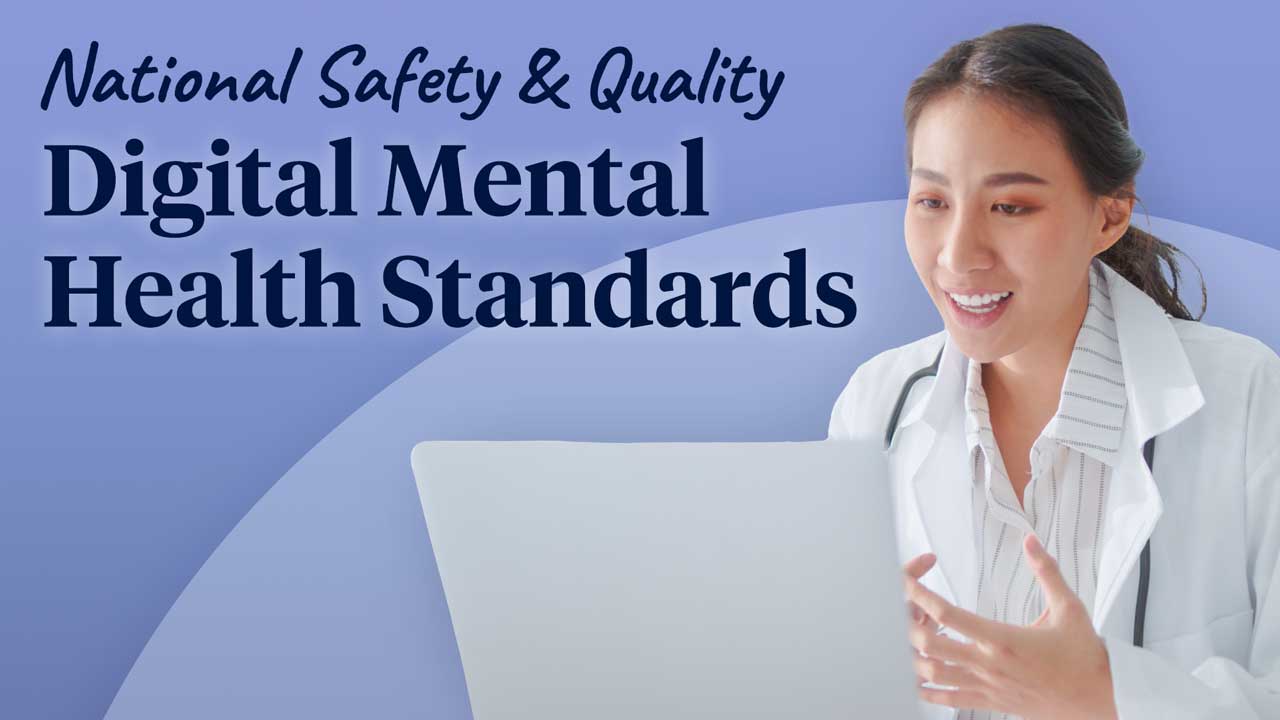This article provides an overview of the National Safety and Quality Digital Mental Health (NSQDMH) Standards, which were released in November 2020.
What?
The National Safety and Quality Digital Mental Health (NSQDMH) Standards.
What is a digital mental health service?
The NSQDMH Standards use a broad definition of ‘digital mental health services’. In the context of these Standards, this term includes mental health, suicide prevention and alcohol/drug services delivered via digital platforms (such as telephone, video conferencing, web-chat, SMS or mobile apps).
However, general wellness apps or software that only support clinicians (like electronic medical records, decision tools, or clinical workflow software) are excluded from the Standards.
In other words, the focus is on services that provide direct support or treatment to service users via digital means.
(ACSQHC 2020)

Who?
The NSQDMH Standards were developed by the Australian Commission on Safety and Quality in Health Care in collaboration with consumers, carers, families, healthcare professionals, service providers and technical experts.
Why?
The NSQDMH Standards aim to:
- Improve the quality of digital mental health services provided
- Protect service users and relevant support individuals from harm.
How?
The NSQDMH Standards provide a quality assurance mechanism for assessing whether applicable systems meet necessary safety and quality requirements. They also establish a nationwide and consistent standard of care that users and their support people can expect from digital mental health services.
What are the Three NSQDMH Standards?
- Clinical and Technical Governance Standard
- Partnering with Consumers Standard
- Model of Care Standard.
This article will provide a brief outline of each Standard.
1. Clinical and Technical Governance Standard
‘Service providers have a responsibility to the community for continuous improvement of the safety and quality of their services, and ensuring that they are person-centred, safe and effective.’
Purpose: To ensure that digital mental health services ‘implement a clinical and technical governance framework that ensures service users and their support people receive safe and high-quality care’.
What Does This Mean?
Technical governance: The framework that guides and oversees the use of digital information and communication technologies.
This Standard describes the need for a clinical and technical governance framework to exist within digital mental health services. The existence and capabilities of this framework should ensure that those who access and work within these services and the broader community can be confident that systems exist to provide safe, effective, person-centred, integrated, high-quality and continually improving mental healthcare.
This Standard contains the following criteria:
- Governance, leadership and culture
- Safety and quality systems
- Workforce qualifications and skills
- Safe environment for the delivery of care.
(ACSQHC 2020)
2. Partnering with Consumers Standard
‘Service providers develop, implement and maintain systems to partner with service users and their support people. These partnerships relate to the planning, design, delivery, measurement, review and evaluation of digital mental health services. The workforce uses these systems to partner with service users and their support people.’
Purpose: To ensure that digital mental health services provide services that offer mutually beneficial outcomes through partnership with service users and their support people in:
- Planning, design, delivery, measurement, review and evaluation of digital mental health services
- Making decisions about their own care, in line with the model of care and to the extent that they choose.
What Does This Mean?
This Standard ensures services provided are person-centred. It describes systems and strategies for involving service users (and, when relevant, their support people) in all aspects of care. In a compliant service, users are included in shared decision-making, are partners in their own care, and help design and evaluate the service they receive.
This Standard recognises the various levels at which partnerships should occur:
- At the individual level: Service users (and their support people) are respected, provided with relevant information, and encouraged to participate in their own care, self‑management and decision‑making.
- At the service level: Service users and their support people contribute to the planning, design, monitoring and evaluation of digital mental health services to ensure they are useable and accessible.
- At the service provider level: Consumers and carers are involved in broader organisational governance, policy and planning, including roles on committees such as clinical or technical governance.
Partnerships with service users, their families and carers are essential for delivering safe, high‑quality digital mental health care. These partnerships should be built on dignity, respect, shared information and opportunities for people to participate in their care to the extent they choose.
This Standard contains the following criteria:
- Partnering with service users in their own care
- Health and digital literacy
- Partnering with service users in design and governance.
(ACSQHC 2020)
3. Model of Care Standard

‘Service providers establish a model of care for each digital mental health service and implement and maintain systems for the delivery of safe and high-quality care to minimise the risk of harm to service users, their support people and others.’
Purpose: To ensure digital mental health services operate under a well‑defined, evidence‑based model of care, where service users and their support people (where appropriate) receive care that is clinically appropriate and aligned with their goals and needs. This includes minimising and managing risks of harm, particularly during transitions of care.
What Does This Mean?
This Standard emphasises that digital mental health services need to demonstrate a model of care based on evidence and best practice to help service users and their support people make informed choices about which services to use.
This Standard contains the following criteria:
- Establishing the model of care
- Delivering the model of care
- Minimising harm
- Communicating for safety
- Recognising and responding to acute deterioration.
Key Considerations
Establishing and delivering the model of care
As digital mental health services operate through different channels and formats, the model of care may not always be obvious to users.
To help remedy this, service providers should:
- Clearly explain how their service works and what outcomes it aims to deliver
- Ensure care is delivered as promised, with clear communication to service users and appropriate engagement with support people
- Put in place systems of accountability to monitor and maintain service quality.
Implementation of this Standard can look different across services, but its core aim is to ensure services are transparent, reliable and safe for users.
Minimising harm and recognising and responding to acute deterioration
Minimising harm in digital mental health services is essential, as the absence of in‑person interactions and environmental cues can make it harder to detect potential harm, including self‑harm or suicide risk.
Service providers, therefore, need effective screening processes and clear response pathways, whether providing direct support or referring to another agency.
Early identification of changes in mood or behaviour is critical to recognising deterioration and preventing serious adverse events, and systematic processes should be in place to respond promptly, including activating emergency assistance if needed.
Communicating for safety
Communication is equally important for safety. Accurate service user identification is required, even in remote or anonymous settings, to maintain continuity of care and protect privacy. Effective communication and documentation are particularly vital when critical information changes or care is transferred, ensuring that service users and their support people remain safe throughout their care journey.
In summary, systems must exist to facilitate:
- Clear articulation and accountability regarding the model of care offered by the service provider
- Identification of service users at risk of harm and timely delivery of targeted prevention and management strategies to protect service users and/or others
- Clear and coordinated communication in order to deliver safe, effective and quality care
- Timely recognition and response to service users suspected of or actively experiencing acute mental state deterioration.
(ACSQHC 2020)
Applying the Standards
The NSQDMH Standards are voluntary and apply at the level of any organisation (or individual provider) that delivers digital mental health services.
Providers use the Standards to self-assess and strengthen their services. Not every action will apply to every service – applicability depends on the size, risk and complexity of the service, and how it is delivered (ACSQHC 2020). For example, a small online peer-support forum may not need the same level of technical infrastructure as a national telehealth hotline.
Providers may offer multiple digital services, and the Standards can be applied differently to each. To fully meet the Standards, providers often need to work closely with the developers and operators of their digital platforms and programs during design and delivery (ACSQHC 2020).
In practice, applying the NSQDMH Standards means reviewing current systems (governance, workforce training, technology, etc.) against the criteria, identifying gaps and taking action to meet the required actions.
Together, the NSQDMH Standards provide a robust framework that enables healthcare services to:
- Establish clinical and technical governance systems that ensure safe care
- Build partnerships with service users and their support people that are safe, effective and person-centred
- Ensure digital mental health services operate under well‑defined and evidence‑based models of care.
Accreditation and Resources

Since late 2022, a formal accreditation scheme has been in place to independently assess compliance with the NSQDMH Standards. The ACSQHC approved three accrediting agencies in 2022, and independent assessments officially began on 1 November 2022 (ACSQHC 2022).
Under this scheme, a digital mental health service provider engages an approved agency to verify evidence that all applicable actions are met. In effect, accreditation means the service has demonstrated robust systems for governance, consumer partnership and care delivery as required by each Standard (ACSQHC 2025).
The Commission maintains a public register of accredited digital mental health services.
Services listed there are rated either:
- ‘Accredited for compliance’ (meaning they meet all applicable actions), or
- ‘Working towards accreditation’ (meaning at least half of the actions are met).
(ACSQHC 2025)
Accredited services may display the official accreditation badge to signal to users that they meet the NSQDMH safety and quality requirements (ACSQHC 2025).
To support implementation, the ACSQHC provides various resources. A self-assessment tool and how-to guide are available online for providers to review and improve their digital services (ACSQHC 2022).
There are also tip sheets and checklists designed for consumers, carers and clinicians to help them choose safe and appropriate digital mental health services (ACSQHC 2022).
For full implementation support and further examples, visit the Australian Commission on Safety and Quality in Healthcare.
In summary, the NSQDMH Standards (and associated resources) give healthcare staff and organisations a clear, evidence-based framework to deliver high-quality digital mental health care, supplementing existing health service standards.
Test Your Knowledge
Question 1 of 5
Which one of the following best describes the main focus of the National Safety and Quality Digital Mental Health (NSQDMH) Standards?
Topics
Further your knowledge
References
- Australian Commission on Safety and Quality in Health Care 2020, National Safety and Quality Digital Mental Health Standards, Australian Government, viewed 5 August 2025, https://www.safetyandquality.gov.au/publications-and-resources/resource-library/national-safety-and-quality-digital-mental-health-standards
- Australian Commission on Safety and Quality in Health Care 2022, ‘Digital Mental Health Standards – Upcoming Accreditation’, Safety and Quality in Health Care Newsroom, 19 July, viewed 5 August 2025, https://www.safetyandquality.gov.au/newsroom/national-standards-updates/digital-mental-health-standards-upcoming-accreditation
- Australian Commission on Safety and Quality in Health Care 2025, NSQDMH Accredited Services, Australian Government, viewed 5 August 2025, https://www.safetyandquality.gov.au/standards/national-safety-and-quality-digital-mental-health-standards/accreditation-national-safety-and-quality-digital-mental-health-standards
 New
New 

